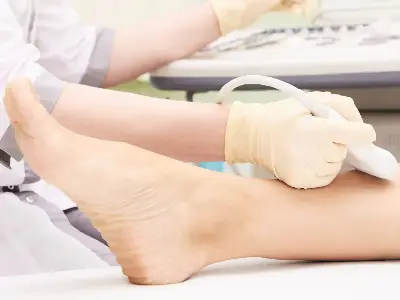Varicose vein sonography in Nashik - Dr. Dipti Deore

Varicose veins: What Are They?
Twisted, projecting veins on the legs caused by an increase in total venous pressure are known as varicose veins. Over time, they tend to enlarge and become more aggressive, and they are usually worn, resulting in hurting, throbbing, and tired legs. After relatively minor injuries, they may suffer more in older age.Increased pressure typically results in skin loss and, in many cases, actual skin ulceration, from which a patient must recover for months without the right care.For varicose or spider veins, Dr. Dipti Deore, a consultant interventional radiologist, suggests the following two non-surgical methods.
1) Radiofrequency ablation or non-surgical laser ablation treatment
An ultrasonography-guided minimally invasive outpatient technique for venous insufficiency is called endovenous (or vein) ablation. An interventional radiologist applies a local anesthetic to the skin above the vein before inserting a thin catheter—roughly the size of a spaghetti strand—into the anomalous saphenous vein. This catheter is used to apply radiofrequency or laser energy to the vein’s inside, sealing it shut.
Dr. Dipti Deore – Best Varicose vein sonography in Nashik
Cytotherapy
Sclerotherapy is a medical procedure used to remove spider and varicose veins. During sclerosing therapy, a salt solution is injected straight into the vein. The blood clot and blood vessel’s lining are burned by the solution, causing them to expand and adhere to one another.
Large, bulging veins called varicose veins typically appear on the legs and feet. They arise from inefficient blood flow caused by inaccurately functioning venous valves.
Treatment for the veins is rarely necessary for medical reasons, although it can be done if there is substantial discomfort, inflammation, and soreness in the legs.
Signs and symptoms
The majority of the time, varicose veins don’t hurt, although symptoms can include:
1) Veins appear twisted, enlarged, and uneven (bulging)
2) The veins are either deep purple or blue.
Reasons
Blood can only flow in one direction because veins have directional valves. If the vein’s valves become stressed and less elastic, or flexible, they may weaken.When a valve is weak, blood can flow backward and eventually in the opposite direction. As a result, blood may pool in the vein(s), causing them to expand and bulge.
Leg veins, which are the furthest from the heart, are frequently impacted. This is because blood flow rearward to the heart is impeded by pressure. Varicose veins can result from any position that causes pressure on the company.
Avoidance
To reduce the likelihood of varicose veins arising:
1) Exercise frequently
2) Maintain a healthy weight
3) Avert spending too much time motionless.
4) Avoid crossing your legs while sitting.
4) Elevate your feet on a pillow as you sit or sleep.
5) Try to get up and move about at least once every thirty minutes if your job requires you to stand all day.
